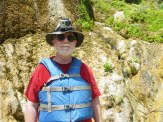It was billed as a “hike” that might take 2.5 hours, but David Hurt, the grand benefactor of Dogwood Canyon Audubon Center, was the guide — at the two hour mark we had just ambled to the blossoming trees in their still-semi-secret location. Amble, not a hike.
Great day to be outside.

David Hurt spent 14 years working to establish the reserve and education center at Dogwood Canyon, in Cedar Hill, Texas — now he just can’t resist leading tours of the better sites and sights.
The voyage is at least half the fun.

After more than a year of serious drought, some of North Texas experienced high rainfall in the past three months. Spring-fed streams and seeps on Cedar Hill and across the Escarpment flow well for the moment, lending hope to wild bird breeding. On some entangled bank . . .

Mr. Hurt often stopped to explain bird songs and habits, and despite his claim not to like “plant people,” he stopped most often to identify plants, or to compare plants that can be confused. This Audubon facility sits in a transitional zone, between two kinds of prairies. It’s forest nature is an oddity in the zone. Dogwood Canyon features plants more commonly identified with the Texas Hill Country and with East Texas, as well as Blackland Prairie plants considered icons of the area. In this case, Hurt showed the differences between Texas redbud and eastern redbud, both of which occur in this area. Hurt carefully demonstrated how to identify poison ivy, now in abundance off the trails. This was a sharp contrast to two weeks ago when I couldn’t find a single sprig of poison ivy to show Scout leaders.

Hurt showed how to make a nest from loose bark strips from Ashe juniper trees. Golden-cheeked warblers, a threatened species, require this bark for nesting, and it can come only from mature Ashe junipers. The birds need this nesting material close to a good stand of deciduous trees, where they catch their food.

The dogwoods in bloom! An early spring, and lots of water, pushed the trees to leaf out before blossoming started — usually the blossoms come first. The drought last year probably hurts blossoming this year. Blossoms are not yet at their peak.

Exquisite aroma and beauty from the dogwood blossoms – not the carpet of white we saw in a previous year. Still just the shock of finding these little beauties in Dallas County adds to their splendor. Dogwoods do well in East Texas, where it is wetter and the soil is acid. Here on the escarpment it is generally dry, hotter, and the soil is thin and alkaline. That the blossoms show up at all is a stunning oddity, a stroke of fortune emblematic of the unique place that is Dogwood Canyon.
Guided hikes — the only way to get to see the blossoms — are planned for Wednesday and Saturday this week. Hikes are limited to 20 people, with two planned for Wednesday, and one for Saturday, March 31. For reservations call Dogwood Canyon Audubon Center at (469) 526-1980.
Previously in Millard Fillmore’s Bathtub:
- The $7 million dogwood blossom [now $8 million]









[…] Early springs force many other plants to blossom early; a photo essay on Dallas’s unusual stan… […]
LikeLike
[…] bird, perhaps a warbler, that I just don’t know (good reason to go spend time at the local Dogwood Canyon Audubon Center, […]
LikeLike
[…] Dogwood Canyon amble for the blossoms (timpanogos.wordpress.com) […]
LikeLike
[…] post was adapted with express permission from Millard Fillmore’s Bathtub. Share history:DiggEmailShare on TumblrLike this:LikeBe the first to like this […]
LikeLike